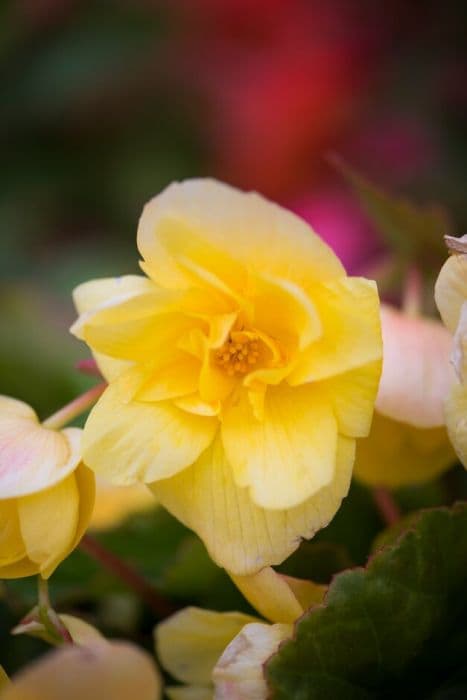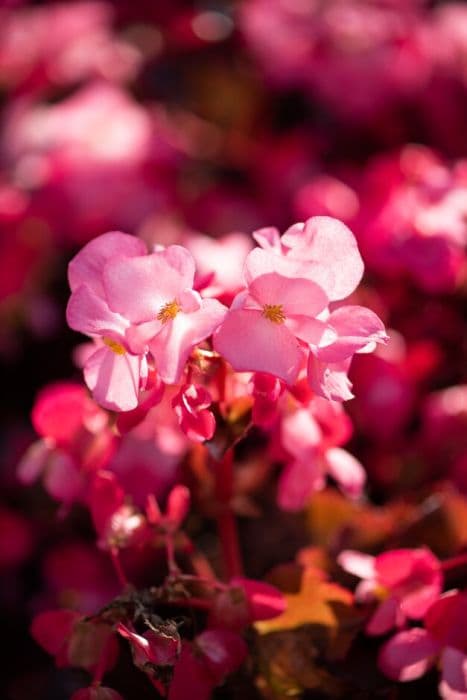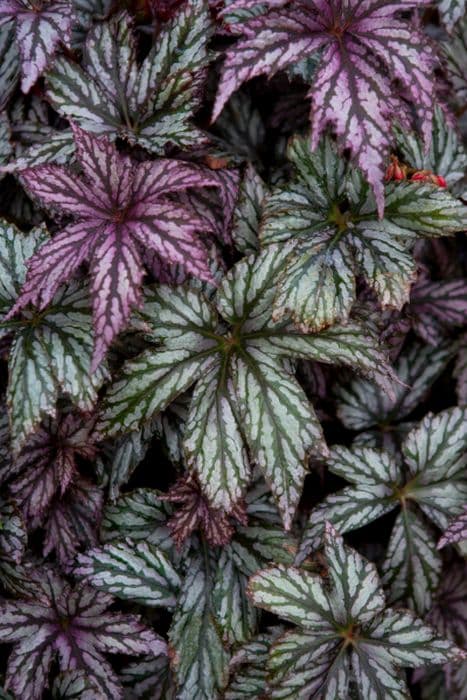Illumination Begonia Begonia 'Illumination Orange' (Illumination Series) (T/d)

ABOUT
Begonia 'Illumination Orange' is a vibrant, ornamental plant known for its showy appearance. The most striking feature of this plant is its profusion of bright orange flowers that dangle in clusters, resembling delicate cascades of color. These flowers are notable for their ruffled edges and a slight sheen that catches the light, creating a luminous effect. Amidst the blooms, the foliage presents a lush backdrop with its rich green leaves that have a glossy texture and a slightly serrated edge. The leaves are typically oblong-shaped and may show subtle hints of red or bronze along the veins or margins, adding further depth to the plant's overall aesthetics. The blossoms and foliage together create a lush, tropical feel that's often used to add a splash of color to hanging baskets, containers, and garden beds, where the trailing habit of Begonia 'Illumination Orange' can be displayed to its full advantage. The cascading growth allows the flowers to spill over the edges of containers, making it an exquisite choice for elevated displays or areas where the trailing effect can be admired. The vibrant orange hue of the flowers ensures that this Begonia variety stands out, providing a warm, energetic visual focus that's particularly effective in sun-drenched spots that highlight the brilliance of the blooms.
About this plant
 Names
NamesSynonyms
Illumination Orange Begonia, Illumination Series Begonia.
Common names
Begonia 'Illumination Orange' (Illumination Series) (T/d).
 Toxicity
ToxicityTo humans
The Begonia, including the variety 'Illumination Orange', is generally considered non-toxic to humans. However, they may cause mild irritation or an allergic reaction if ingested or if the sap comes in contact with the skin. If a person consumes any part of the Begonia, they might experience symptoms like nausea, vomiting, or salivation. In most cases, symptoms are typically mild and self-limiting, but seeking medical advice is recommended if ingestion occurs.
To pets
Begonias, including the 'Illumination Orange', are toxic to pets. If a pet ingests part of a Begonia plant, they could experience symptoms like oral irritation, drooling, vomiting, and difficulty swallowing due to the soluble calcium oxalates in the plant. In severe cases, ingestion can lead to kidney failure, particularly in cats. If you suspect your pet has ingested Begonia, it is important to consult with a veterinarian immediately.
 Characteristics
CharacteristicsLife cycle
Perennials
Foliage type
Deciduous
Color of leaves
Green
Flower color
Orange
Height
1 foot 2 inches (35-45 cm)
Spread
1 foot 2 inches (35-45 cm)
Plant type
Herb
Hardiness zones
10
Native area
Tropical and subtropical regions
Benefits
 General Benefits
General Benefits- Enhances Aesthetics: Adds bright, vibrant orange color to gardens and hanging baskets.
- Low Maintenance: Requires minimal care, making it ideal for busy gardeners or those with limited gardening experience.
- Drought Tolerant: Can withstand periods without water, reducing the need for frequent watering.
- Shade Tolerant: Thrives in shaded areas where other plants may struggle, increasing gardening options.
- Blooms Profusely: Produces a wealth of flowers throughout the blooming season, adding constant visual interest.
- Attracts Pollinators: Flowers can attract beneficial insects like butterflies, helping to pollinate other plants in the garden.
- Versatile: Suitable for container gardening, window boxes, and landscape borders, offering flexibility in use.
- Long Flowering Period: Offers a long season of color from spring to frost, providing sustained beauty.
- Trailing Habit: Features a cascading growth that is ideal for creating stunning visual effects in hanging baskets and over walls.
 Medical Properties
Medical PropertiesThis plant is not used for medical purposes.
 Air-purifying Qualities
Air-purifying QualitiesThis plant is not specifically known for air purifying qualities.
 Other Uses
Other Uses- The Illumination Orange Begonia can be used in terrariums due to its vibrant color and ability to thrive in high humidity environments.
- These flowers can be used as a natural dye for fabrics, providing a unique orange hue to textiles.
- The petals of Begonia 'Illumination Orange' can be pressed and used in craft projects such as making homemade paper or botanical prints.
- The plant can serve as an indicator for over-watering in mixed plant containers, as Begonia 'Illumination Orange' is sensitive to excessive moisture.
- Illumination Orange Begonia can be grown in hanging baskets to create living curtains that provide light filtration and privacy on porches or patios.
- Leaves from the Illumination Orange Begonia can be used in culinary presentations as garnish due to their ornamental value, though they are not edible.
- The distinctive shape of the leaves can be used for educational purposes in botanical art classes, illustrating plant structure and leaf forms.
- The wax-like flowers of the Illumination Orange Begonia can be used in flower arrangements that require longevity without water, such as bridal bouquets and corsages.
- Dried Illumination Orange Begonia flowers can be incorporated into potpourri mixtures for a subtle hint of color and texture contrast.
- During festive seasons, potted Illumination Orange Begonias can be gifted as a symbol of warmth and happiness due to their bright flowers.
Interesting Facts
 Feng Shui
Feng ShuiThe Begonia is not used in Feng Shui practice.
 Plant Symbolism
Plant Symbolism- Caution: Begonias in general symbolize caution and a message to be wary.
- Harmony: The balancing and lush appearance of the begonia flower is often associated with harmony and peace.
- Gratitude: The gift of a begonia can be a way to express thankfulness and appreciation for someone's friendship or efforts.
- Individuality: The myriad varieties and vibrant colors of begonias can represent uniqueness and standing out from the crowd.
- Warmth and Friendly Gestures: The orange color in 'Illumination Orange' Begonias can also signify warmth, happiness, and jovial exchanges between friends.
 Water
WaterThe Illumination Begonia should be watered thoroughly, allowing the top inch of soil to dry out between waterings. Depending on the humidity and temperature, this might mean watering once or twice a week. Typically, use about 16 to 24 ounces of water for each plant during each watering session. Avoid letting the plant sit in water as it can lead to root rot. It's best to water these plants in the morning to allow foliage to dry out during the day.
 Light
LightIllumination Begonias thrive in bright, indirect sunlight. An east-facing window where the light is gentle in the morning is ideal, or you can place them in a room with a sheer curtain to diffuse intense light. Avoid direct afternoon sunlight as it can scorch their leaves.
 Temperature
TemperatureFor Illumination Begonias, a temperature range of 60°F to 75°F is ideal. These plants can handle a minimum temperature of 50°F but should not be exposed to temperatures below that. They should also not be placed in areas above 86°F as higher temperatures could damage the plant.
 Pruning
PruningIllumination Begonias benefit from pruning to encourage bushier growth and to maintain their shape. Prune them in the spring before the growing season. Deadhead flowers and remove any dead or yellowing leaves to ensure the plant's energy is directed towards new growth. Pruning can be done every few weeks to keep the plant tidy.
 Cleaning
CleaningAs needed
 Soil
SoilFor Begonia 'Illumination Orange', a well-draining soil mix is optimal. Combine peat moss, perlite, and pine bark in equal parts for ideal texture and drainage. The preferred pH range for this begonia is slightly acidic to neutral, around 5.5 to 6.5. Regular soil tests and amendments can maintain the ideal pH and health of the plant.
 Repotting
RepottingBegonia 'Illumination Orange' typically needs repotting every 1 to 2 years, or when it becomes root-bound. It's best to repot in spring or early summer, using a fresh soil mix as described to refresh nutrients and encourage growth.
 Humidity & Misting
Humidity & MistingBegonia 'Illumination Orange' thrives in high humidity conditions. Ideally, maintain indoor humidity levels around 50-70% for the most vigorous growth. Avoid placing the plant in dry air environments or near heating vents which can reduce the humidity levels drastically.
 Suitable locations
Suitable locationsIndoor
Place in bright, indirect light and keep soil moist.
Outdoor
Partial shade, sheltered location, well-draining soil.
Hardiness zone
10-11 USDA
 Life cycle
Life cycleBegonia 'Illumination Orange' begins its life cycle as a seed, germinating in warm, moist soil within a few weeks under the right conditions. After germination, the seedling emerges and grows into a young plant with characteristic foliage and begins to develop its root system. As it matures, the begonia enters the vegetative stage, where it focuses on leaf and stem growth, building a robust plant structure. Once the plant has enough resources and environmental conditions are favorable, it enters the flowering stage, producing vibrant orange blooms that attract pollinators and can last multiple seasons with proper care. Following pollination, if it occurs, the plant may produce seed capsules that upon maturity release seeds and complete the reproductive cycle. Over time, Begonia 'Illumination Orange' may become less vigorous, at which point it can be propagated from cuttings or tubers to rejuvenate and continue the life cycle.
 Propogation
PropogationPropogation time
Spring-Early Summer
Begonia 'Illumination Orange' is commonly propagated through stem cuttings. The best time to propagate is during the growing season, which is typically spring or summer, when the plant is actively growing and can better recover from the stress of cutting. To propagate by stem cuttings, choose a healthy, non-flowering stem and cut a 4 to 6-inch (about 10 to 15 cm) segment. Make sure the cutting has a few leaves, and remove the bottom leaves to expose the nodes where the roots will form. Dip the cut end in rooting hormone powder to encourage root development. Then, plant the cutting in a soilless mix or a mixture of peat and perlite, making sure to keep the soil consistently moist but not waterlogged. Place the cutting in indirect sunlight and within a few weeks, you should begin to see new growth as the cutting takes root.



![Begonia [Bonfire]](/_next/image?url=https%3A%2F%2Fplants-admin.emdemapps.com%2Fimages%2Fplants%2F%2Fimages%2F604b6124363f0.png&w=640&q=75)


![Begonia [Devotion]](/_next/image?url=https%3A%2F%2Fplants-admin.emdemapps.com%2Fimages%2Fplants%2F%2Fimages%2F604b58183573b.png&w=640&q=75)


